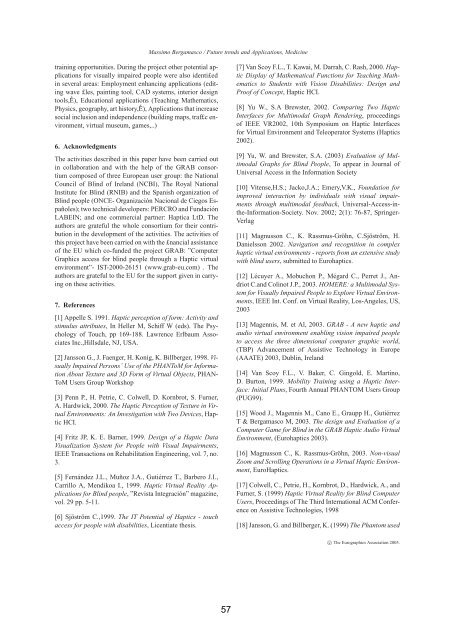full Paper - Nguyen Dang Binh
full Paper - Nguyen Dang Binh
full Paper - Nguyen Dang Binh
Create successful ePaper yourself
Turn your PDF publications into a flip-book with our unique Google optimized e-Paper software.
training opportunities. During the project other potential applications<br />
for visually impaired people were also identi£ed<br />
in several areas: Employment enhancing applications (editing<br />
wave £les, painting tool, CAD systems, interior design<br />
tools, ³E), Educational applications (Teaching Mathematics,<br />
Physics, geography, art history, ³E), Applications that increase<br />
social inclusion and independence (building maps, traf£c environment,<br />
virtual museum, games,..)<br />
6. Acknowledgments<br />
The activities described in this paper have been carried out<br />
in collaboration and with the help of the GRAB consortium<br />
composed of three European user group: the National<br />
Council of Blind of Ireland (NCBI), The Royal National<br />
Institute for Blind (RNIB) and the Spanish organization of<br />
Blind people (ONCE- Organización Nacional de Ciegos Españoles);<br />
two technical developers: PERCRO and Fundación<br />
LABEIN; and one commercial partner: Haptica LtD. The<br />
authors are grateful the whole consortium for their contribution<br />
in the development of the activities. The activities of<br />
this project have been carried on with the £nancial assistance<br />
of the EU which co-funded the project GRAB: ”Computer<br />
Graphics access for blind people through a Haptic virtual<br />
environment”- IST-2000-26151 (www.grab-eu.com) . The<br />
authors are grateful to the EU for the support given in carrying<br />
on these activities.<br />
7. References<br />
[1] Appelle S. 1991. Haptic perception of form: Activity and<br />
stimulus attributes, In Heller M, Schiff W (eds). The Psychology<br />
of Touch, pp 169-188. Lawrence Erlbaum Associates<br />
Inc.,Hillsdale, NJ, USA.<br />
[2] Jansson G., J. Faenger, H. Konig, K. Billberger, 1998. Visually<br />
Impaired Persons’ Use of the PHANToM for Information<br />
About Texture and 3D Form of Virtual Objects, PHAN-<br />
ToM Users Group Workshop<br />
[3] Penn P., H. Petrie, C. Colwell, D. Kornbrot, S. Furner,<br />
A. Hardwick, 2000. The Haptic Perception of Texture in Virtual<br />
Environments: An Investigation with Two Devices, Haptic<br />
HCI.<br />
[4] Fritz JP, K. E. Barner, 1999. Design of a Haptic Data<br />
Visualization System for People with Visual Impairments,<br />
IEEE Transactions on Rehabilitation Engineering, vol. 7, no.<br />
3.<br />
[5] Fernández J.L., Muñoz J.A., Gutiérrez T., Barbero J.I.,<br />
Carrillo A, Mendikoa I., 1999. Haptic Virtual Reality Applications<br />
for Blind people, ”Revista Integración” magazine,<br />
vol. 29 pp. 5-11.<br />
[6] Sjöström C.,1999. The IT Potential of Haptics - touch<br />
access for people with disabilities, Licentiate thesis.<br />
Massimo Bergamasco / Future trends and Applications, Medicine<br />
57<br />
[7] Van Scoy F.L., T. Kawai, M. Darrah, C. Rash, 2000. Haptic<br />
Display of Mathematical Functions for Teaching Mathematics<br />
to Students with Vision Disabilities: Design and<br />
Proof of Concept, Haptic HCI.<br />
[8] Yu W., S.A Brewster, 2002. Comparing Two Haptic<br />
Interfaces for Multimodal Graph Rendering, proceedings<br />
of IEEE VR2002, 10th Symposium on Haptic Interfaces<br />
for Virtual Environment and Teleoperator Systems (Haptics<br />
2002).<br />
[9] Yu, W. and Brewster, S.A. (2003) Evaluation of Multimodal<br />
Graphs for Blind People, To appear in Journal of<br />
Universal Access in the Information Society<br />
[10] Vitense,H.S.; Jacko,J.A.; Emery,V.K., Foundation for<br />
improved interaction by individuals with visual impairments<br />
through multimodal feedback, Universal-Access-inthe-Information-Society.<br />
Nov. 2002; 2(1): 76-87, Springer-<br />
Verlag<br />
[11] Magnusson C., K. Rassmus-Gröhn, C.Sjöström, H.<br />
Danielsson 2002. Navigation and recognition in complex<br />
haptic virtual environments - reports from an extensive study<br />
with blind users, submitted to Eurohaptics.<br />
[12] Lécuyer A., Mobuchon P., Mégard C., Perret J., Andriot<br />
C.and Colinot J.P., 2003. HOMERE: a Multimodal System<br />
for Visually Impaired People to Explore Virtual Environments,<br />
IEEE Int. Conf. on Virtual Reality, Los-Angeles, US,<br />
2003<br />
[13] Magennis, M. et Al, 2003. GRAB - A new haptic and<br />
audio virtual environment enabling vision impaired people<br />
to access the three dimensional computer graphic world,<br />
(TBP) Advancement of Assistive Technology in Europe<br />
(AAATE) 2003, Dublin, Ireland<br />
[14] Van Scoy F.L., V. Baker, C. Gingold, E. Martino,<br />
D. Burton, 1999. Mobility Training using a Haptic Interface:<br />
Initial Plans, Fourth Annual PHANTOM Users Group<br />
(PUG99).<br />
[15] Wood J., Magennis M., Cano E., Graupp H., Gutiérrez<br />
T & Bergamasco M, 2003. The design and Evaluation of a<br />
Computer Game for Blind in the GRAB Haptic Audio Virtual<br />
Environment, (Eurohaptics 2003).<br />
[16] Magnusson C., K. Rassmus-Gröhn, 2003. Non-visual<br />
Zoom and Scrolling Operations in a Virtual Haptic Environment,<br />
EuroHaptics.<br />
[17] Colwell, C., Petrie, H., Kornbrot, D., Hardwick, A., and<br />
Furner, S. (1999) Haptic Virtual Reality for Blind Computer<br />
Users, Proceedings of The Third International ACM Conference<br />
on Assistive Technologies, 1998<br />
[18] Jansson, G. and Billberger, K. (1999) The Phantom used<br />
c○ The Eurographics Association 2005.
















